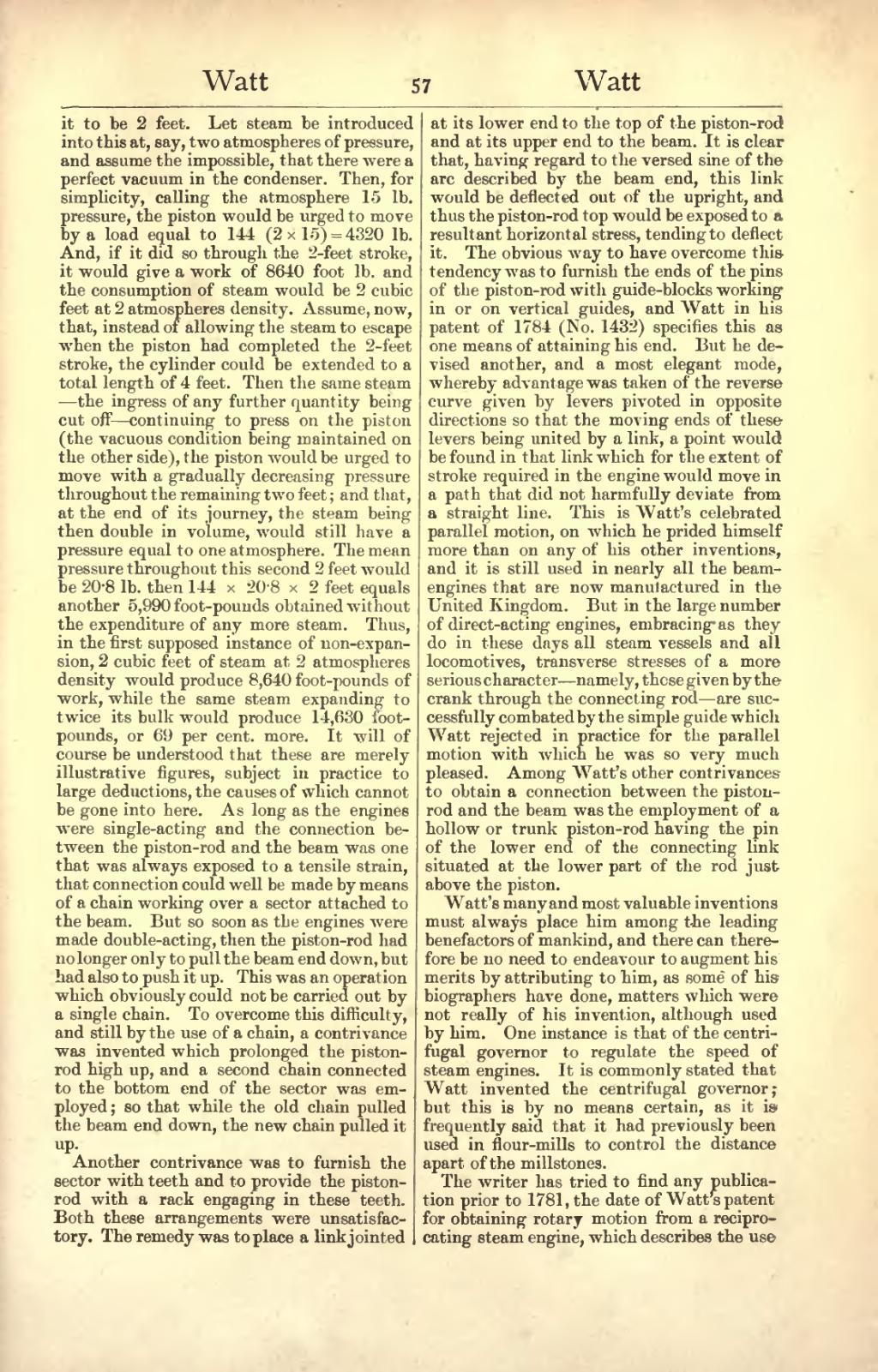it to be 2 feet. Let steam be introduced into this at, say, two atmospheres of pressure, and assume the impossible, that there were a perfect vacuum in the condenser. Then, for simplicity, calling the atmosphere 15 lb. pressure, the piston would be urged to move by a load equal to 144 (2 × 15) = 4320 lb. And, if it did so through the 2-feet stroke, it would give a work of 8640 foot lb. and the consumption of steam would be 2 cubic feet at 2 atmospheres density. Assume, now, that, instead of allowing the steam to escape when the piston had completed the 2-feet stroke, the cylinder could be extended to a total length of 4 feet. Then the same steam—the ingress of any further quantity being cut off—continuing to press on the piston (the vacuous condition being maintained on the other side), the piston would be urged to move with a gradually decreasing pressure throughout the remaining two feet; and that, at the end of its journey, the steam being then double in volume, would still have a pressure equal to one atmosphere. The mean pressure throughout this second 2 feet would be 20.8 lb. then 144 × 20.8 × 2 feet equals another 5,990 foot-pounds obtained without the expenditure of any more steam. Thus, in the first supposed instance of non-expansion, 2 cubic feet of steam at 2 atmospheres density would produce 8,640 foot-pounds of work, while the same steam expanding to twice its bulk would produce 14,630 foot-pounds, or 69 per cent. more. It will of course be understood that these are merely illustrative figures, subject in practice to large deductions, the causes of which cannot be gone into here. As long as the engines were single-acting and the connection between the piston-rod and the beam was one that was always exposed to a tensile strain, that connection could well be made by means of a chain working over a sector attached to the beam. But so soon as the engines were made double-acting, then the piston-rod had no longer only to pull the beam end down, but had also to push it up. This was an operation which obviously could not be carried out by a single chain. To overcome this difficulty, and still by the use of a chain, a contrivance was invented which prolonged the piston-rod high up, and a second chain connected to the bottom end of the sector was employed; so that while the old chain pulled the beam end down, the new chain pulled it up.
Another contrivance was to furnish the sector with teeth and to provide the piston-rod with a rack engaging in these teeth. Both these arrangements were unsatisfactory. The remedy was to place a link jointed at its lower end to the top of the piston-rod and at its upper end to the beam. It is clear that, having regard to the versed sine of the arc described by the beam end, this link would be deflected out of the upright, and thus the piston-rod top would be exposed to a resultant horizontal stress, tending to deflect it. The obvious way to have overcome this tendency was to furnish the ends of the pins of the piston-rod with guide-blocks working in or on vertical guides, and Watt in his patent of 1784 (No. 1432) specifies this as one means of attaining his end. But he devised another, and a most elegant mode, whereby advantage was taken of the reverse curve given by levers pivoted in opposite directions so that the moving ends of these levers being united by a link, a point would be found in that link which for the extent of stroke required in the engine would move in a path that did not harmfully deviate from a straight line. This is Watt's celebrated parallel motion, on which he prided himself more than on any of his other inventions, and it is still used in nearly all the beam-engines that are now manufactured in the United Kingdom. But in the large number of direct-acting engines, embracing as they do in these days all steam vessels and all locomotives, transverse stresses of a more serious character—namely, those given by the crank through the connecting rod—are successfully combated by the simple guide which Watt rejected in practice for the parallel motion with which he was so very much pleased. Among Watt's other contrivances to obtain a connection between the piston-rod and the beam was the employment of a hollow or trunk piston-rod having the pin of the lower end of the connecting link situated at the lower part of the rod just above the piston.
Watt's many and most valuable inventions must always place him among the leading benefactors of mankind, and there can therefore be no need to endeavour to augment his merits by attributing to him, as some of his biographers have done, matters which were not really of his invention, although used by him. One instance is that of the centrifugal governor to regulate the speed of steam engines. It is commonly stated that Watt invented the centrifugal governor; but this is by no means certain, as it is frequently said that it had previously been used in flour-mills to control the distance apart of the millstones.
The writer has tried to find any publication prior to 1781, the date of Watt's patent for obtaining rotary motion from a reciprocating steam engine, which describes the use
